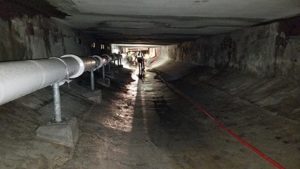
Do rainwater and wastewater use the same sewers? Let’s find out.
Have you ever heard water flowing through the storm drain after a downpour or smelled sewage wafting from the storm drains? Have you ever wondered where the water from your faucets goes? There is much more to your neighborhood’s water pipes than the nearby inlet and your home’s faucets. Below is a description of the different types of sewer systems you’ll find, particularly stormwater systems and sewers.
Stormwater Systems (MS4s)
Stormwater systems have other names, such as storm sewers and MS4s (municipal separate storm sewer systems.) These systems are entirely separate from the main sewer line. MS4s allow untreated water from the outdoors to flow through a series of pipes at a steady rate into the local waterways. Only rain and snowmelt should go through the stormwater system.
Parts of a storm sewer you might be familiar with are inlets, culverts, and manholes. Manholes allow utility workers to access the system at different points. Culverts are outdoor pipes that allow stormwater to travel under roads. Meanwhile, inlets are slits or grates along the curb that allow stormwater to drain off the road.
You should never dump anything into a storm drain that is not clean water. Anything from swimming pool water to pet waste to grass clippings should never enter the stormwater system. Debris can clog the pipes and cause flooding, and chemical waste and fecal matter will pollute the natural waterways.
Sewer Lines
Sewer lines, also known as sanitary sewers, take untreated gray or black water to the nearest wastewater treatment plant. The water might come from your kitchen or bathroom faucets, shower, or toilet. At the wastewater treatment plant, the water goes through a series of treatment tanks that sift out debris and kill pathogens with chlorine. The treated water goes out into the natural waterways.
Combined Sewer System
Older sewer systems, especially those built prior to 1900, are more likely to be combined sewer systems. These pipelines take both wastewater and stormwater to the nearest wastewater treatment plant. When the system is too full, it will evacuate some of the untreated water into the local waterways.
Contact Jet Blast Inc. Today!
Jet Blast® Industrial Services strives every day in an effort to provide our customers with the best service and equipment possible. Providing a safe and stable workplace has allowed us to keep a team of quality people with most having a tenure of 15 – 25 years with Jet Blast®. With all that experience under one roof, we have been able to provide reliable 24-hour service since 1979. I believe this helps to set us apart from the competition.
Compare us! Let us make your job easier. If you’re located in Maryland, Pennsylvania, Delaware, Northern Virginia, or Washington, D.C., contact us by email at [email protected], call us at 410-636-0730, or fax us at 410-789-3907, and don’t forget to keep in touch with us on Facebook!
